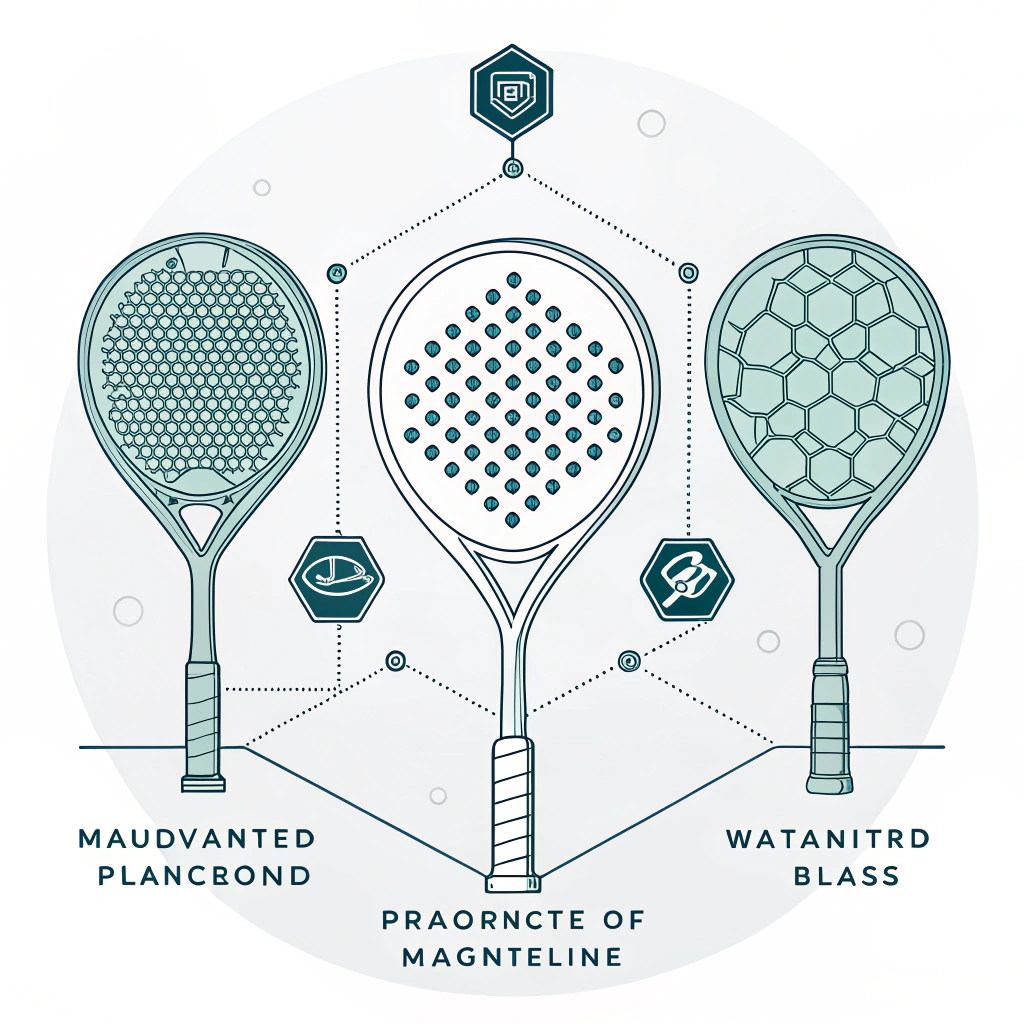The best padel racket option for professional play balances advanced materials, precision engineering1 and design innovation to meet high-performance requirements. This article offers a detailed comparison of racket shapes, materials, and custom options to help you make informed B2B purchasing decisions.
As B2B decision-makers, you face the challenge of selecting sports equipment that not only meets but exceeds your customers' expectations. With increasing demands for precision, durability, and customization, it is crucial to understand the differences between padel racket options. Our evaluation focuses on technical aspects such as carbon fiber quality2 (ranging from 3k to 18k), glass fiber integration, and design shapes (Diamond, Round, and Teardrop). We will explore how these elements translate into on-court performance, durability, and brand reputation.
In today’s competitive market, the padel racket needs to be more than just a piece of sports equipment. It must be engineered with precision to provide enhanced control, power, and maneuverability. Manufacturers like NEX Padel use advanced techniques and strict quality control measures to ensure that every racket meets high standards. For B2B buyers in sports retail and club management, understanding these nuances can directly impact product positioning and overall customer satisfaction.
Padel rackets come in various shapes, each designed to cater to different playing styles and skill levels. Below is a detailed table comparing the key characteristics of each shape:
| Attribute | Diamond Shape | Round Shape | Sweet Spot3 |
|---|---|---|---|
| Sweet Spot | Smaller but moves towards the top of the racket | Larger, centralized sweet spot for better forgiveness | Moderate, balancing power and control |
| Power | Offers enhanced power for aggressive play | Provides excellent maneuverability with controlled power | Combines elements of power and ease of control |
| Control | Requires high skill; best for professionals | Suited for intermediates due to forgiving control patterns | Ideal for players transitioning between styles |
| Player Suitability | Professionals seeking high-powered shots | Beginners to intermediates who prefer comfort | Intermediate to advanced players looking for balance |
| Technical Emphasis | Greater emphasis on precise engineering | More focus on distribution of impact force | A compromise that benefits versatility |
This comparative decision framework is essential for selecting a racket that aligns with your target market’s requirements. A Diamond racket typically suits professionals who need aggressive power, while the Round shape is ideal for players focused on consistency and ease of use. The Teardrop shape, offering a mix of both, often appeals to a broader range of players.
Material selection is at the heart of padel racket performance. Manufacturers use various advanced materials to optimize weight distribution, stiffness, and durability:
- Glass Fiber: Provides flexibility and shock absorption. It is typically used in entry-level rackets or as a supplementary material to add comfort.
-
Carbon Fiber (3k, 12k, 18k):
- 3k Carbon Fiber: Used for a balance between performance and cost. It offers moderate reinforcement.
- 12k Carbon Fiber: Improves stiffness and stability, ideal for intermediate performance requirements.
- 18k Carbon Fiber: Provides high stiffness and durability, preferred in professional-grade rackets for maximum power transfer and precision.
Manufacturing techniques involving these materials are critical. Companies like NEX Padel utilize strict quality control methods and innovative production processes to ensure each racket performs consistently under high demands. The material composition not only affects the weight and strength of the racket but also influences its vibration dampening and overall handling.
To simplify decision-making for procurement managers, consider the following key points:
- Durability: Higher grades of carbon fiber, like 18k, result in rackets that sustain performance over prolonged use.
- Precision Engineering: Advanced production techniques ensure that even custom shapes and designs deliver consistent performance.
- Cost vs. Performance: Investing in superior materials may result in a higher unit cost but can lead to better customer satisfaction due to enhanced playability and longevity.
Including a variety of material technologies in your product line can address different market segments and help you cater to both high-end customers and those with budget constraints.
In today's marketplace, a padel racket is more than just a tool for play – it is a statement of brand identity. Our manufacturing process supports extensive customization4 options:
- Shape Customization: We offer three primary shapes (Diamond, Round, and Teardrop) and can develop completely custom shapes based on client requirements.
- Custom Prints and Colors: Ensure that every racket can reflect brand-specific designs, making them an excellent tool for marketing and brand reinforcement.
- Personalized Hand Grip and Handle Covers: Custom logos can be imprinted on hand grips and handle covers, adding a further layer of personalization.
For sports clubs and retailers, these customization options provide a way to offer exclusive products that stand out in a competitive market. Custom designs help build customer loyalty and reinforce brand prestige. Moreover, the ability to customize plays a significant role in effective merchandising and differentiation.
Adopting a tailored approach when marketing rackets not only satisfies the end user but also enables significant differentiation in crowded markets. Providing proof of robust manufacturing processes and technical innovation can be a decisive factor when clubs and stores commit to exclusive brand deals.
When evaluating padel rackets, both technical specifications and real-world performance data should be considered. The primary performance metrics include:
- Sweet Spot Size: Directly related to rackets’ playability. A larger sweet spot implies more forgiveness for strikes that are off-center.
- **Stiffness and Vibration Dampening5: Measured through material properties and manufacturing processes, these factors contribute to the control and comfort experienced during play.
- Weight Distribution: Critical for maneuverability and swing speed. High-performance rackets ensure a balanced distribution that enhances both power and control.
- Durability and Longevity: Derived from high-quality materials like advanced carbon fiber and stringent quality testing processes.
A table summarizing performance metrics can provide clarity during the decision-making process:
| Metric | Impact on Performance | Key Considerations for B2B Buyers |
|---|---|---|
| Sweet Spot | Larger area increases shot accuracy and forgiveness | Aligns with player skill levels and market segmentation |
| Stiffness | Increased stiffness means better power transfer | Critical for professional-grade equipment |
| Weight Distribution | Affects swing control and speed | Balance must be optimized for target consumer demographics |
| Vibration Dampening | Greater dampening enhances comfort | Reduces player fatigue and improves overall playing experience |
| Material Quality | Ensures long-term durability and performance | Higher carbon fiber grades command premium pricing |
For procurement managers, ensuring that the padel rackets meet or exceed these performance standards is crucial. Each parameter impacts not just the end user’s play experience but also the reputation of the sports retail brand or club.
Manufacturing expertise combined with technical innovation positions companies like NEX Padel as trusted partners for B2B purchasers. With a portfolio that caters to significant brands such as Hirostar, Reebok, and Starvie, our advanced production techniques are validated by industry leaders and professional players alike.
Our recommendations for B2B decision-makers in this space are clear:
- Prioritize Quality and Precision: Evaluate the specific performance metrics of padel rackets based on material composition and design. Invest in rackets that use higher-grade carbon fiber if your clients demand high competitive performance.
- Consider Customization as a Differentiator: Custom shapes, prints, and branding options can add significant value and help your brand stand out.
- Balance Cost and Performance: Understand that while premium materials and advanced engineering may come at a higher cost, they can ensure greater long-term customer satisfaction and competitive advantage.
By incorporating these factors into your purchasing strategy, you will not only enhance your product portfolio but also build strong partnerships with manufacturers committed to excellence.
It is essential that your sales and distribution teams are knowledgeable about these technical details. Training sessions and product demonstrations can help bridge the gap between technical specifications and customer needs. This approach ensures that end users understand the benefits of their investment and see the value beyond the price tag.
Choosing the right padel racket for professional play involves a comprehensive evaluation of material quality, manufacturing technology, and design specifications. With advanced options like custom shapes and personalized branding, the decision is not merely about selecting a product—it is about aligning with an innovation-driven partner that supports your brand’s vision.
For B2B buyers, leveraging detailed technical specifications and performance data can help justify procurement decisions and develop marketing strategies aimed at professionals. The insights presented here are designed to equip you with the knowledge needed to evaluate and compare various options in the high-performance sports equipment market.
As you move forward, consider scheduling a consultation with our experts at NEX Padel. We are here to provide further technical insights, product demonstrations, and customized solutions tailored to your specific market needs.
People Also Ask
Q1: Do expensive padel rackets make a difference?
A: More expensive padel rackets often incorporate advanced materials and precise engineering, which can lead to enhanced power and control. However, for beginners or intermediate players, the benefits may not justify the cost as these rackets can have smaller sweet spots and require more technical play.
Q2: Which brand makes the best padel racket?
A: The best padel racket brand depends on your specific performance needs and target market. Leading companies, including Head, Wilson, and Babolat, are known for their innovation and quality. NEX Padel also partners with well-known brands like Hirostar and Starvie, delivering high-performance rackets that combine advanced material technology with exceptional durability.
Q3: What padel racket shape do pros use?
A: Professionals often favor the diamond-shaped padel rackets for their power and precision. This shape provides a moderate sweet spot that supports high speed shots, though some players may opt for round or teardrop shapes to achieve a more balanced performance.
-
precision engineering: Read the article to understand how precision in design and manufacturing enhances product performance and reliability. ^Return ↩
-
carbon fiber quality: Explore insights on carbon fiber grades (3k to 18k) and their impact on racket durability, stiffness, and overall performance. ^Return ↩
-
Sweet Spot: Discover why the sweet spot is critical in racket design and how its size affects shot accuracy and player forgiveness. ^Return ↩
-
customization: Understand the benefits of customization in sports equipment, including brand differentiation and tailored performance features. ^Return ↩
-
Vibration Dampening: Learn about vibration dampening techniques and material properties that contribute to reduced shock and improved playability. ^Return ↩







